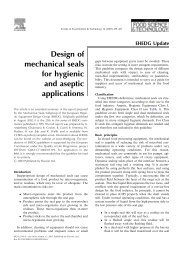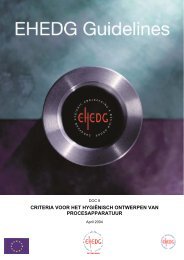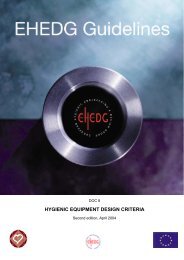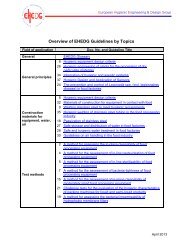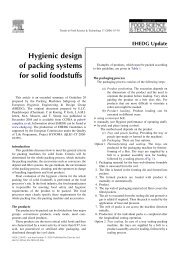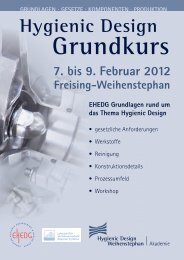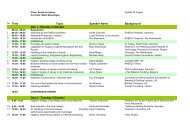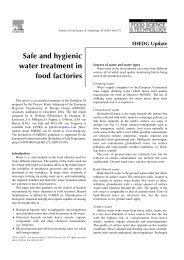Yearbook 2013/2014 - ehedg
Yearbook 2013/2014 - ehedg
Yearbook 2013/2014 - ehedg
You also want an ePaper? Increase the reach of your titles
YUMPU automatically turns print PDFs into web optimized ePapers that Google loves.
Hygienic automation technology in food production 119<br />
The fundamental challenge of cleaning<br />
All manufacturers are liable for their products. In the food and<br />
beverage industry, complete product safety, especially from<br />
a microbiological standpoint, must be ensured to protect the<br />
consumer. As such, one important aspect involves designing<br />
components and systems with hygiene and ease of cleaning<br />
in mind in order to guarantee exemplary cleanliness, shortest<br />
possible cleaning times and minimal expense.<br />
To avoid drives failing in aggressive environments, for<br />
example, the component materials must have certain<br />
qualities that make them suitable for reliably withstanding<br />
the prevailing ambient conditions, as well as guaranteeing<br />
full functionality and a long service life. This applies to both<br />
the materials used for the drive unit and those used for<br />
interface components, such as connections and seals.<br />
Seals and lubricants that comply with FDA regulations<br />
must be used for system components that come into<br />
contact with food. Depending on the requirements of the<br />
specific application, there is a choice of valve types either<br />
for normal cleaning or for applications using intensive foam<br />
cleaning. Intensive cleaning of machine parts also can<br />
wash out the lubricating grease and impair the operation<br />
of the components. Using dry-running seals ensures that<br />
the washed out machine components still function reliably<br />
(Figure 4).<br />
Figure 4: Dry-running seals are indispensable for a reliable<br />
functionality, even when the lubricant has been washed out.<br />
Clean and safe!<br />
Many potential sources of contamination in food and<br />
packaging systems such as bacteria, chemical influences<br />
or corrosion particles in the factory can be eliminated with<br />
just a few design tweaks. Easy-to-clean, corrosion-resistant<br />
system components make food production safer.<br />
When buying food, the consumer expects high-quality<br />
products that have been hygienically produced, dispensed<br />
and packaged by the food industry. That is why customerspecific<br />
process and factory automation solutions are an<br />
important part of any hygienic value-added chain.<br />
Table 1. Important European standards and legislation pertaining<br />
to hygienic design of equipment and components used in food<br />
production environments.<br />
2006/42/EC<br />
ISO 21469<br />
EN 1672-2<br />
ISO14159<br />
EHEDG Doc 8<br />
EHEDG Doc 10<br />
EHEDG Doc 13<br />
1935/2004/EC<br />
Plastics Directive<br />
10/2011<br />
FDA CFR 21<br />
Festo<br />
Directive 2006/42/EC of the European<br />
Parliament and of the Council of 17<br />
May 2006 on machinery, and amending<br />
Directive 95/16/EC (recast)<br />
Safety of machinery – Lubricants with<br />
incidental product contact – Hygiene<br />
requirements<br />
Food processing machinery – Basic<br />
concepts – Part 2: Hygiene requirements<br />
Safety of machinery - Hygiene requirements<br />
for the design of machinery (IS=<br />
141:2002)<br />
Hygienic equipment design criteria<br />
Hygienic design of closed equipment<br />
for processing of liquid food<br />
Hygienic design of open equipment for<br />
processing of food<br />
Regulation (EC) NO 1935/2004 of the<br />
European Parliament and of the Council<br />
of 27 October 2004 on materials<br />
and articles intended to come into contact<br />
with food and repealing Directives<br />
80/590/EEC and 89/109/EEC<br />
Commission regulation (EU) No<br />
10/2011 of 14 January 2011 on plastic<br />
materials and articles intended to come<br />
into contact with food<br />
Food & Drugs, Part 11 “Electronic<br />
Records, Electronic Signatures”<br />
Product overview for the food and<br />
beverage industry, 7 th edition



